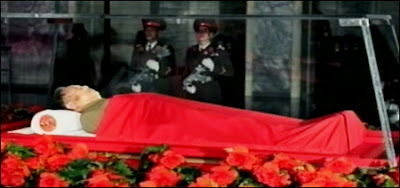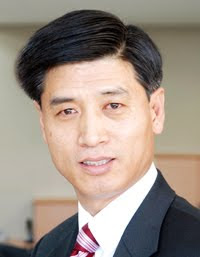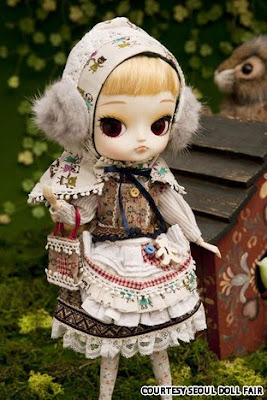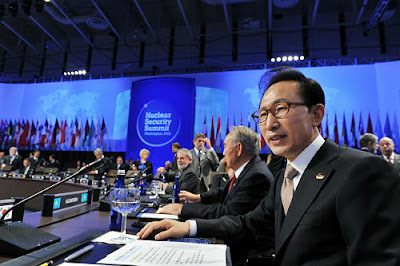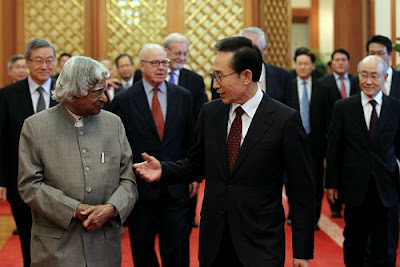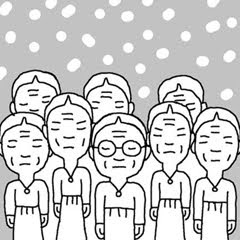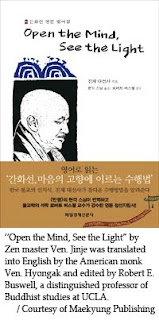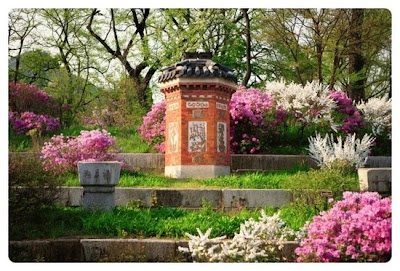Well we all know that there is a vast geographical and cultural differences. There is harldly any proximity when it comes to the physical, cultural and well as geographical.One is a homogenous and the other one is a heterogenous country.
But we all know that famous Buddhism faith flourish from the lap of India . When I start studying about Koreaan studies first time in my school I encounter one of the interesting legendary about the dynamic country of India and the mysterious country of Korea.
The India-Korea cultural connection goes back to the second century. There is a legendary story, Koreans believe that a prince called Kim Suro married the princess of Ayodhya.
As we all know that Buddhism started from India and it has spread every where specially in the East Asian countries. But, unfortunately Buddhism has not able to flourish much in India where it was born. We learned about how a Buddhist monk went to the other part of the world to flourished the idea and philosophy of Buddhism.
That's how we started our Korean studies, it was very tactful and enthusiastic ways of my professor who introduced us in the very first day and proceed our class on Korean history and society.
I was so amazed by the story and the very next day I started exploring internet to know more about this particular story. Because there was geographically distance from India to Korea numbers of country in between both the countries.
Anyway , the destiny has bring both the countries to have a connection somehow and it happened to be like these. Both the countires suffered from the big powerful countries like Japan and England. Both the countries has undergone from the various phases and come out as a winner. Both the countires acheived their freedom of the very same day i.e 15th August. And both the countries has seperated their parts and formed South Korea and North Korea on the otherhand India and Pakistan.
Above all these, India Korea started their political relation during the regin of Prime Minister Narsimha Rao. And became the first Prime Minister who visited Korea and make a strong ties in the field of political and trade relationship. And this year the President of Korea beame the guest of India's Republic day and signed some of the agreement between India and Korea for the progressive opportunities in the near future.
Today , again while having cultural discussion with other friends in my class the Korean teacher asked about the relationship between India and Korea, which has reminded me of date back of King Suro of Gaya Kingdom and his legendary story and how it developed India Korea ties.
But one of the most intersting part was the legendary story of "Ayodhya princess and the Korean King Suro of Korea". The legend of the Indian princess is narrated in Samguk Yusa, a Korean text written by a monk, Iryon (1206 AD-1289 AD). It is set in the Kaya kingdom in the first century CE.
For the video clip see this give link
http://blog.naver.com/korea_brand/10079446525
Historical and cultural contacts between the two peoples trace back to ancient times.
According to “Samguk-Yusa" or "The Heritage History of the Three Kingdoms," written in the 13th century, a princess from Ayodhya came to Korea and married King Kim Su-ro and became Queen Hur Hwang-ok in the year 48 AD . The enduring philosophy of the Buddha, which has influenced the lives and thoughts of the people of the two countries, has also provided a strong linkage.
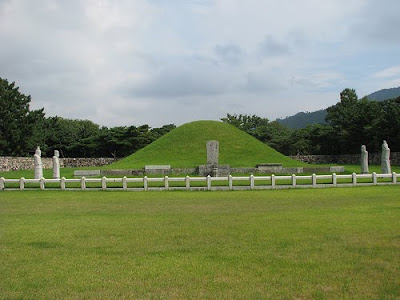
Kim Suro's Tomb
The rationale for a close relationship between India and South Korea has been reinforced in modern times by political and economic imperatives.
Gimhae, the city where the Indian princess from Ayodhya landed and married Kim Su-ro, signed an MOU establishing a sister-city relationship with Faizabad-Ayodhya. A monument in memory of the princess was erected in March 2001 at a site donated by the Ayodhya administration.
Busan and Mumbai signed an MOU on mutual cooperation in 1977. Gyeonggi Province signed an MOU for mutual benefit with the State Government of Maharashtra in March 2007. Seoul has a sister-city relationship with Mumbai and has expressed interest in establishing a sister-city relationship with Delhi. And twinning between Pocheon & Jaipur and Incheon & Kolkata is at an advanced stage.

During the visit of President Dr. A.P.J. Abdul Kalam, the first by any president of India to the ROK, the signing of a Joint Ministerial Statement on the Launching of a Joint Task Force to develop a Comprehensive Economic Partnership Agreement (CEPA) between the two countries was held. Two other Agreements viz. Agreement on Cooperation in the fields of Science and Technology and Agreement on Cooperation and Mutual Assistance in Customs Matters were also signed during the visit. An MOU on Scientific and Technological Cooperation between the Department of Science and Technology and the India and Korea Industrial Technology Foundation (KOTEF) was also signed separately.
Bilateral CEPA negotiations have formally concluded and the CEPA has since been signed. Some of the highlights include the fact that the CEPA binds South Korea to phase out or reduce tariffs on 90 percent of Indian goods over 10 years, while India is to eliminate tariffs on 85 percent of South Korean exports within the same period, which is longer than what is written in other FTAs South Korea has signed. In addition to tariff reduction, South Korea will be able to move into various industrial sectors of the Indian economy, such as food processing, textiles, garments, chemicals, metals and machinery. The deal also opens the service and investment sector, with India accepting South Korean company inflows in its telecom, accounting, medical and advertising markets, as well as allowing South Korean financial firms in the investment market. With respect to rules of origin, both countries agreed on the allowable level of foreign contents to be up to 65 percent. South Korea expects massive inflows of information technology (IT) workers, engineers and English teachers as both sides agreed to allow temporary migration of professional workers.

Hundai Company India
Two-way trade between India and South Korea has gathered momentum recently, making South Korea the 12th largest trading partner for India. In the last four years alone, trade volume has gone up more than two and half times. As against a target of US$10 billion, bilateral trade is expected to exceed $16 billion in 2008.
South Korea is the 4th largest investor in India in terms of actual inflow of FDI into India. During the first three quarters of 2008, for which data is available, 164 investment proposals from 52 Korean companies for a proposed total investment of $243 million approved. The cumulative investment from South Korea in India has been $1.46 billion in terms of actual flow from 382 Korean companies for over 900 projects.
The ROK’s investments in India have largely taken place in the transportation industry, energy (power and oil refinery), electrical equipment (including computer software & electronics), chemicals (other than fertilizer), commercial, office & household equipments, metallurgical Industries and food processing pndustries. Major South Korean companies active in India include Hyundai Motor, Samsung Electronics, LG, Lotte Group and Doosan Heavy Industries. Now, major South Korean companies like Samsung, Hyundai and LG are expanding production facilities in India and smaller companies are focusing on technical collaborations. The Lotte Group acquired Parry’s Confectionery Chennai in 2004. Samsung Electronics opened a mobile phone plant in the state of Haryana in March 2006. Samsung Engineering has opened its Global Engineering Centre in New Delhi.
A remarkable feature of South Korea is its transformation from a developing country in the 1950s to a high-income country with a substantial per capita income today. The economic reforms of the 1990s in India were influenced by East-Asian successes and South Korea was among the chief countries to have an impact on Indian policymakers' thinking process. Though consular relations between India and South Korea were set up in 1962, it was in 1973 with the establishment of formal diplomatic ties that a new chapter was opened in the history of Indo-Korean cooperation.
Both India and Korea contribute significantly to the world GDP. Korea is among the few Asian countries that are counted among the developed countries of the world; India, too, has a growing stature and increasing role in international affairs.
The vision statement includes the prospective areas of growth for Korea and India are shipping and port development, infrastructure development, tourism and hospitality industries, agro food industries in addition to auto, communication and IT industries, which are already present in India. At the SME level, the following areas could be suitable for joint ventures, technology transfer and 100-percent .
With respective governments support in business community, positively and with the growing amount of globalization and liberalization, not only Korean companies are making their big role in India, Indian firms too are establishing themselves in Korea.
There is another famous Indian poet Rabindranath Tagore and his historical linkage. A short poem by Tagore in which he called Korea ‘The Lamp of the East”’became the rallying point for Korean nationalists fighting during Japanese colonisation, so much so that it is quoted even today in most diplomatic exchanges.
Noble Laureate Rabindranath Tagore composed a short but evocative poem in 1929 about Korea's glorious past and bright future. He wrote:

"In the golden age of Asia
Korea was one of its lamp bearers,
And that lamp is waiting
To be lighted once again
For the illumination of the East."
There is a movie called Finding Kim Jong Wook, starring popular lead pair Gung Yoo and Im Soo-Jeong, based on love story about two Korean tourists who meet in India.

An Indian movie called Gangster , in this most of the location were shotat Korea.

Culturally both the countries have ties from the olden day . Now with the help of flourishing IT sector Korean product is in every household names. Now we are awaiting for the real Korean wave in Inda with famous K-POP, Movies and other cultural activities.




